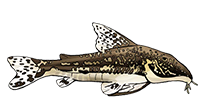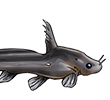From the paper's discussion section: "this study shows that, along the phylogeny of some teleosts such as C. paleatus," ...Plaul et al. wrote: ABSTRACT
The Neotropical catfish, (Callichthyidae) is a facultative air-breathing teleost that makes use of the caudal portion of the intestine as an accessory air-breathing organ. This portion is highly modified, being well vascularized with capillaries between epithelial cells, which makes it well suited for gas exchange. Instead, the cranial portion is a digestion and absorption site, as it has a typical intestinal epithelium with columnar cells arranged in a single row, villi and less vascularized tunica mucosa. Therefore, the intestine was studied by light and electron microscopy to assess differences between the cranial, middle and caudal portions. To characterize the potential for cell proliferation of this organ, we used anti-proliferating cell nuclear antigen antibody and anti-Na+K+-ATPase monoclonal antibody to detect the presence of Na+/K+ pump. In C. paleatus it was observed that cell dynamics showed a decreasing gradient of proliferation in cranio-caudal direction. Also, the intestine of this catfish is an important organ in ionoregulation: the basolateral Na+/K+ pump may have an active role, transporting Na+ out of the cell while helping to maintain the repose potential and to regulate cellular volume.
- "the intestine has acquired the role of an accessory respiratory organ, probably as a response to unfavorable environmental conditions, while maintaining the morphological characteristics for perform the absorption process."
- "the cranial portion of the intestine is the site of digestion and absorption, since its structure is the one typical of all vertebrates."
- [The middle and caudal portions of the intestine] "perform the function of a respiratory organ because their mucosa becomes thinner, villi are not observed, gas bubbles are present and cuboidal or squamous enterocytes are in close contact with the capillary network, which may even reach the lumen of the organ."
- "the caudal portion [has] morphological characteristics, such as the abundance of mitochondria and the complexity of the basolateral folds, which would be associated with osmoregulation, recirculation of water, and ion transport"
By contrast, this paper and the sources it cites state that the fish gulp air and pass the air through their gut all the way to the posterior end of their intestines, where gas exchange occurs and then they "fart" out the used air. That is not at all what I thought happens. I am curious about the transit time of such gulped air: Assuming that the air must either move WITH the digesting food in the gut (which could take minutes or hours to reach the posterior intestine) or move PASSED the digesting food (floating around and past the partially digested meal), how does this become metabolically efficient? If oxygen levels are low, how long can the fish wait for fresh air to reach their middle and posterior intestines? I suppose that as long as the fish is continuously gulping air, there will be a constant supply of oxygen available to the posterior intestine - in that case this seems very reasonable. But if the fish were to experience acute (sudden) hypoxia, I would imagine that the transit time for air to reach the intestine from the mouth might be insufficient.... Clearly there's a lot we don't know here, but it is fascinating.
I don't own paleatus, but I do own aeneus, which (according to the authors) is also capable of this. So I'm going to be looking for fish farts in the future.
Cheers, Eric







/g/s/1.jpg)











